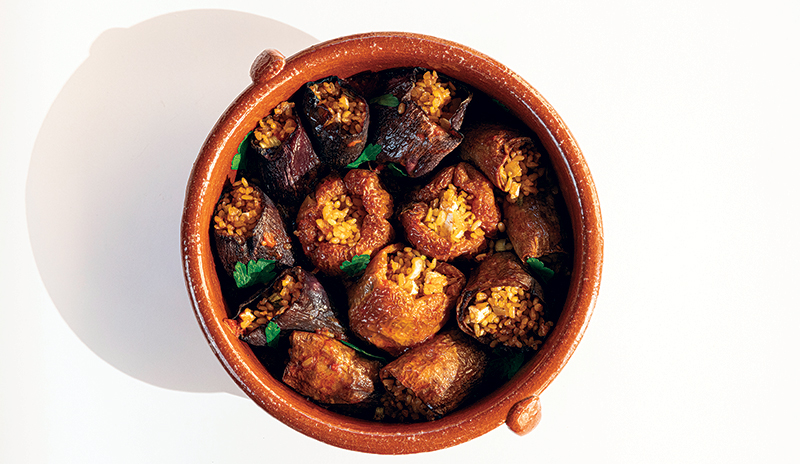
As I write this, we are experiencing the coldest temperatures of the year, snow on the ground, icicles dangling from the eaves—and I have a hankering for a hint of summer. I could go to the grocery store and find some insipid tomatoes or perhaps a softening and well-traveled eggplant, both picked before ripeness (and flavor!) has even begun to insinuate itself, and with texture and flavor even more compromised by long storage. Those, however, are not the true flavors of summer. A better-tasting alternative (and one with a much longer history) hangs right in my pantry—summer vegetables, particularly eggplant, dried at the height of flavor, waiting for just such a moment.
I first encountered dried eggplant hanging in market stalls while traveling in Turkey. I had no idea what they were and had to ask—for dolmas (the Turkish word for “stuffed”) I was told. They look like odd chains of purplish-black bells strung together on cotton cords, and I found them draped in dramatic displays almost everywhere I found Turkish foodstuffs for sale. Remembering past interrogations at the Customs counter, watching my various unusual food items go into overflowing trash bins behind the security officials, I decided to forgo the purchase. Besides, they looked much too fragile to survive the journey in my already overflowing luggage.
Recently, however, I was pleasantly surprised to find several cellophane bags of the strings of dried eggplant at Shahrazad (12605 Metcalf Avenue) and then a few days later, a bag of dried zucchini and ropes of dried sweet peppers at Mediterranean Market (1404 Westport Road). A little internet surfing was all it took to find preparation techniques and how they are traditionally used—stuffed with a mixture of rice (sometimes other grains) and lamb or beef. Traditions aside, to me they are vessels for endless varieties of fillings—great for appetizers, lunch, brunch, or dinner; excellent on a buffet table; as a side dish; or as an element of an expansive tapas spread. Regardless of how you use them, they’re sure to bring a little summer sunshine into your winter kitchen. If nothing else, they look great hanging in your pantry, reminding you of the sunny season to come.
Stuffed Dried Eggplant with Bulgur, Herbs, and Feta
Although quite fragile in their dried state, once rehydrated, dried eggplant (and peppers, and zucchini) are surprisingly resilient, and even if they do tear or have small holes, they are still usable for most fillings. The amount of filling here—a very basic and traditional stuffing to familiarize yourself with the concept—will stuff at least 20 pieces of dried eggplant (or other vegetables—see In Your Pantry below) and can certainly be reduced or increased as needed. In my recipe testing, my favorite base for stuffing was bulgur, perhaps because of its novelty. (I use it less frequently than rice in daily cooking.) I also made this version vegetarian as I am trying to eat less red meat this year.
Begin by bringing a pot of lightly salted water to a boil and cook the dried eggplant and/or other vegetables for about 6 minutes. Transfer them to a bowl of cold water to cool for a few minutes, reserving the boiling liquid. Dice and sauté half an onion and 2 large garlic cloves (finely chopped) until translucent, about 4 minutes. Transfer the cooked onion and garlic to a mixing bowl. Add one cup coarse bulgur (or rice, or freekeh, orzo, or couscous—cooking times may vary slightly, but you’ll figure it out) and a half cup of the reserved cooking liquid. Next, stir/mash in one tablespoon of pepper paste (Middle Eastern style, or even Gojuchang) or a pinch of red pepper flakes, 1/4 cup golden raisins, 1/2 cup chopped parsley, 3 scallions (green and white parts, chopped), a drizzle of extra-virgin olive oil, and a big pinch of salt and black pepper. Traditional recipes frequently use a spoonful of dried mint, but if you have a window box with any fresh herbs struggling to get through the winter, this would be a great place to use them—mint, chives, marjoram, oregano, even cilantro could be nice. Taste the filling and see if it needs anything—the pepper paste may not be spicy enough for you, herbs may need tweaking—and adjust as necessary. Another traditional ingredient is a generous shot of pomegranate molasses or some type of acidifying agent, such as ground sumac, yogurt, or even lemon juice, and I find this addition a delicious inclusion. The brightness of the sour taste brings a little more summer flavor into the dish. Finally, stir in a 1/3 to a 1/2 cup of crumbled feta or other appropriate cheese. Chopped nuts would be nice, too, although I didn’t use any in this recipe.
Lightly oil a baking dish or oven-proof skillet. One at a time, fill each eggplant piece about three quarters full (the filling will need room to expand as it absorbs moisture and cooks). Lay the stuffed eggplant around the vessel, slightly overlapping each so that it stands up to help keep the filling from tumbling out. Continue until all the vegetables are filled. In a bowl, whisk together a few tablespoons of tomato paste and 1 to 2 cups of water—I use the leftover water from hydrating the vegetables. You could also use tomato sauce (diluted) that might be hanging out in the fridge—on one occasion I used a partial jar of tomato salsa, and it was quite tasty. If you like spicy things, stir in a tablespoon of sambal oelek or other piquant pepper ingredient. Pour this mixture over the stuffed vegetables to the point that they are half-way submerged. Any leftover stuffing mixture can be cooked with a little water in a covered dish or reserved to use later. Cover the dish and either cook in a 350F oven or simmer on the stove top for about 30 minutes, checking occasionally to see that the dish isn’t dry and in need of a bit more water. Test to see that the eggplant is tender, and the filling is cooked to your liking. It may need 15 or so minutes more. Serve the stuffed vegetables warm, although they can also be eaten at room temperature. Pomegranate molasses makes a lovely condiment with this traditional version of the dish, as would yogurt, tzatziki, or even a tangy tahini dressing.
The next time you think you have nothing to eat, take out your dried eggplant, and examine the fridge and pantry. There are likely some delicious tidbits just waiting to be recycled into a memorable meal. If you’re lucky, you might even find a little warm sunshine to bring to this occasionally dreary and frigid time of year.
In Your Pantry: Dried Produce
For thousands of years, humans have found ways to preserve foodstuffs for the bleak and barren seasons. Here are some ancient ingredients to fire your imagination.
 Dried Vegetables for Stuffing
Dried Vegetables for Stuffing
Eggplant, zucchini, and peppers (see below) are wonderful vehicles for stuffing. After rehydrating they can be stuffed, cooked, and used in many ways. Any good quality ground or chopped meats or seafood would be welcome here. Fillings may be cooked or raw or a combination, just take their state into consideration of cooking time. For more ideas from previous issues of the In the Kitchen column, check out these recipes for fillings or mixes to make good stuffing: Resourcefulness Jan. ’23, the Lamb Kebab mix May ’22, Late Summer Meatballs Sept. ’21, Stuffed Peppers Aug. ’21, Swiss Chard Rolls Sept. ’18.
 Mushrooms
Mushrooms
Dried mushrooms are an excellent source of flavor, especially the flavor enhancer glutamate, lending savor and umami to any dish they grace. Porcini (aka cepes) are one of the most desirable dried mushrooms in Western cuisine and can be found in most grocery stores, although packages are frequently adulterated with other less expensive (and less flavorful) mushrooms, which takes careful inspection to detect. Always buy from a reputable source (or use it as an excuse to go to Italy where they are much easier to find and less expensive). Trumpets of Death, a black, horn-shaped, and distinctly flavored mushroom is less common, but also worth seeking out. They, like most mushrooms, are a wonderful partner for potatoes, cream, and fish. Dome-shaped dried shiitake are a staple in Asian cuisines, great to have on hand for an impromptu savory broth, sauce, stir fry, or braise.
 Peppers
Peppers
Since their spread from the New World across the globe, different pepper varieties have been bred to enhance specific characteristics and are one of the most universally dried vegetables. From mild and sweet (the string in the photo) to complex and even smoky (the large New Mexican chiles) to devastatingly fiery (the tiny diavolino from Abruzzo), keep in mind that the size of the pepper isn’t necessarily what’s important—it’s knowing exactly what you have and how to use it. When in doubt, taste only the tiniest bit to be certain. And always wash your hands after chopping or handling. You could get yourself in trouble.


